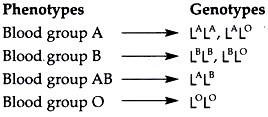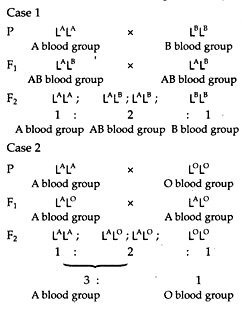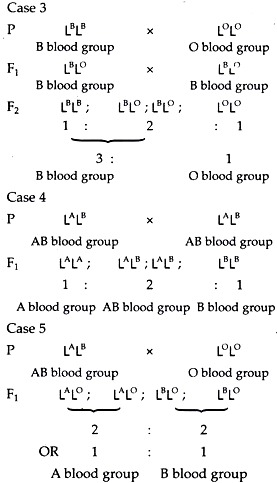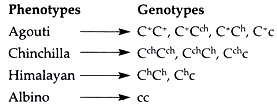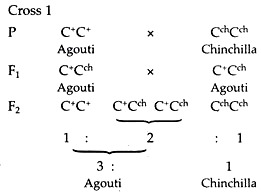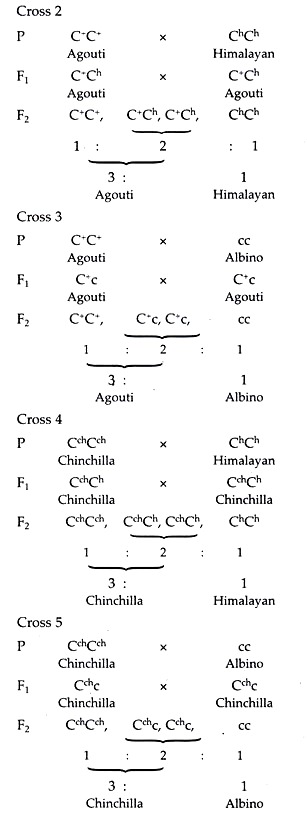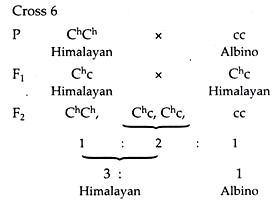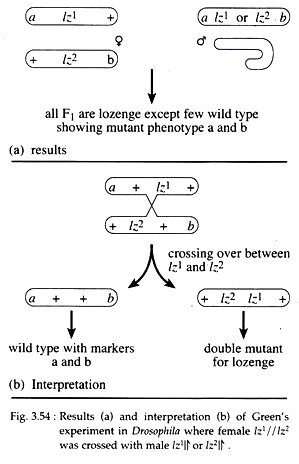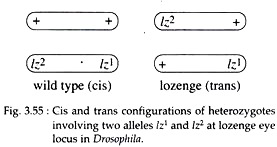In this article we will discuss about:- 1. Meaning of of Allelle 2. Concept of Multiple Allele 3. Dominance Hierarchy of Blood-group Alleles 4. Isoalleles 5. Pseudoalleles.
Contents:
- Meaning of of Allelle
- Concept of Multiple Allele
- Dominance Hierarchy of Blood-group Alleles
- Isoalleles
- Pseudoalleles
1. Meaning of of Allelle:
William Bateson, first coined the term ‘allelomorph’ (alternative form), meaning one of an array of different forms of a gene. Later, this term was shortened by others to ‘allele’. So allele is defined as one of two or more alternative forms of a single gene. Alleles of a given gene occupy the same locus on homologous chromosomes.
ADVERTISEMENTS:
Each of the different alleles of a single gene have a unique nucleotide sequence, and their activities are all concerned with the same biochemical and developmental process, although their individual phenotypes may differ. For example, tall and dwarf are alleles determining the height of the pea plant.
The allele that occurs most frequently in a population, is arbitrarily designated as normal, and often referred to as the wild type allele. This allele is usually dominant, for example, the allele for tall plants in garden pea as studied by Mendel. A mutant allele contains modified genetic information and often specifies an altered gene product.
For a given character, the phenotype is determined by different combinations of alternative form of a single gene. How does alleles act to influence a given phenotype? Actually the process of mutation is the source of new allele and each new allele leads to a change in the phenotype.
Usually, the alteration or mutation is expressed as a loss of the specific wild-type function. For example, if a gene is responsible for the synthesis of a specific enzyme, a mutation in the gene may change the conformation of this enzyme and may eliminate its affinity for the substrate.
ADVERTISEMENTS:
Such a mutation will result in a total loss of function. Conversely, another organism may have a different mutation in the same gene, representing a different allele.
Symbolizing Alleles:
Alleles are symbolized variously. Mendel used the lower case form of the initial letter of a recessive trait’s name to denote the recessive allele and the same letter in upper case refers to the dominant allele.
Thus, for tall and dwarf, where dwarf is recessive, D and d represent the alleles responsible for these respective traits. Another useful system was developed to discriminate between wild and mutant traits, that uses the initial letter, or a combination of two or three letters of the name of the mutant trait.
ADVERTISEMENTS:
If the trait is recessive, the lower case form is used, if it is dominant, the upper case form is used. In another system the contrasting wild type trait is denoted by the lower case initial letter of the recessive trait, but with a superscript. For example, ebony is a recessive body colour mutation in Drosophila. The normal body colour is gray. Using the above system, ebony is designated by e, while gray by e+.
So a diploid fly may thus exhibit one of three possible genotypes:
e+//e+ : gray homozygote (wild type)
e+//e : gray heterozygote (wild type)
e//e : ebony homozygote (mutant)
The slashes between the letters indicate that the two allele-designation represent the same locus on two homologous chromosomes.
Lethal Alleles:
An allele that results in the death of an organism is called a lethal allele. Mutation resulting in a gene product that is nonfunctional can sometimes be tolerated in the heterozygous state; that is, one wild type allele may produce enough of the essential product for the organism to survive. Such a mutation behaves as a recessive lethal allele. However, homozygous recessive individuals will not survive.
In some cases, the allele responsible for a lethal effect in homozygotes may show a distinctive mutant phenotype in heterozygotes. Such an allele is behaving as a recessive lethal but is dominant with respect to the phenotype.
ADVERTISEMENTS:
In Drosophila, curly wing (cy), plum-eye (pm) behave as homozygous lethals but are dominant with respect to the expression of the mutant phenotype when heterozygous.
In instances, where the heterozygote will not survive, the mutation is behaving as dominant lethal allele, because its presence somehow overrides the expression of the wild-type product, or the amount of wild type product is simply insufficient to support its essential function.
For example, the Huntington disease of human is due to a dominant allele, H. Dominant lethal alleles are rarely observed. For them to exist in a population, the affected individual must reproduce before the allele’s lethality is expressed, as can occur in Huntington disease.
2. Concept of Multiple Allele:
According to Mendel’s concept of inheritance, each gene has two alternative forms or allelomorphs, one being dominant or partially dominant and the other recessive; one being wild form and the other mutant. If the mutant type is developed from the wild type due to mutation, then it will not be wrong to expect that the wild type can mutate in more than one way.
Again, the mutant type can also mutate once again to give rise to another mutant form. Therefore, a gene can have more than two allelomorphs, and relationship between such different alleles may or may not be a simple dominant-recessive relationship. So some genes have more than two allelic forms. Such existence of more than two allelic forms of the same gene is called multiple allelism.
Multiple alleles mean more than two allelic forms of a single gene, that arise by mutation of the same wild-type gene and that occupy the same locus in a given pair of homologous chromosomes, e.g., multiple alleles for coat-colour gene in rabbit, multiple alleles for ABO blood groups in man etc.
Multiple alleles of the same gene influence the same phenotypic trait. Of the multiple alleles of a given gene, any two can be present at a time in a diploid individual. Since multiple alleles occupy the same locus in homologous chromosomes, no crossing over occurs between them. They usually show a hierarchy of dominance-recessiveness.
The wild-type allele is usually fully dominant over all others. One mutant allele is usually fully recessive to all others. The other alleles in a multiple allelic series may show different degrees of dominance in different cases.
Landsteiner (1900-1902) recognised A, B and O blood groups in man, on the basis of presence or absence of A and B antigens on the surface of RBC. In 1902, two of his students Von De Castello and Sturli also discovered the 4th and most rare blood group AB. The characteristics and transfusion reactions of blood groups are summarized in Table 3.6.
Bernstein (1925) showed that the gene ‘L’ (named after Landsteiner) for ABO blood groups can occur in 3 allelic forms—LA, LB and L°. LA and LB specify A and B antigens respectively and Lo specifies no antigen.
3. Dominance Hierarchy of Blood-group Alleles:
In the multiples alleles of ABO blood-group, LA and LB alleles are dominant over Lo. So both are co-dominant to each other. Thus the ABO blood series provides a good example of co-dominance. Co-dominance is a situation in which the hetero- zygote exhibits the phenotypes of both homozygotes.
Because the phenotypes of both homozygotes are expressed, co-dominance differs from incomplete dominance in which the heterozygote exhibits a phenotype intermediate between the two homozygotes e.g., heterozygote LALB individuals have the blood group AB, because both the A antigen (product of the LA allele) and the B antigen (product of the LB allele) are produced. Thus, LA and LB alleles are co-dominant.
So the dominance hierarchy is:
LA = LB > L°
Genotypes of different blood-groups:
As LA and LB are co-dominant and Lo is recessive to both of them, the genotypes for different blood-groups are as follows:
Inheritance of multiple alleles for ABO blood groups:
The inheritance pattern of multiple alleles for ABO blood-groups can be understood from the following cases:
It appears that the inheritance pattern of ABO blood groups in human follows basic Mendelian principles.
Multiple allele for coat-colour in Rabbits:
Another example for multiple allele is coat colour genes in rabbit.
The different coat colours in rabbit and the multiple alleles controlling these colours are as follows:
i. Agouti:
Rabbits with wild-type or ‘agouti’ of full colour have a brownish gray coat. The allele for full colour may be designated as C+.
ii. Chinchilla:
Rabbits with the mutant coat-colour, “chinchilla” have silvery- gray coat. The allele for ‘chinchilla’ is called Cch.
iii. Himalayan:
Rabbits with the mutant coat-colour, ‘Himalayan’ have white coat with black at the extremities like nose, ears, feet and tail. The allele for “Himalayan” coat is called ‘Ch‘.
iv. Albino: doubt
Rabbits with the mutant coat- colour ‘albino’ are with completely white coat. The allele for ‘albino’ coat is called c.
Hierarchy of dominance-recessiveness amongst the multiple alleles for coat-colours in rabbits:
The multiple alleles for coat colours in rabbits show the following hierarchy of dominance-recessiveness:
C+ > Cch > Ch > C.
This means C+ is dominant over Cch, Ch and c. Cch is recessive to C but dominant over Ch and c. Ch is recessive to C+ and Cch but dominant over c. Finally, c is recessive to C+, Cch and Ch.
Genotypes for different coat-colours in rabbits:
Due to the above hierarchy of dominance-recessiveness amongst the multiple alleles, the different coat-colours in rabbits may have different genotypes.
Inheritance pattern of multiple alleles for coat-colours in rabbits:
One may get the idea about the inheritance pattern of multiple alleles for coat-colours in rabbit through the following monohybrid crosses:
4. Isoalleles:
Within a series of multiple alleles, each of which may again have slightly different forms, that give almost similar phenotypes like multiple allele. Such alleles expressing themselves within the same phenotypic range are called iso-alleles. If the phenotype is wild, these are normal or wild iso-alleles, and if the phenotype is mutant, they will be called mutant iso-alleles.
No crossing over occurs in such iso-alleles. For example, A allele of ABO blood group has A1, A2 and A3 iso-alleles. Again in Drosophila, several alleles viz., W+s, W+c and W+s, exhibit red eye colour and are not ordinarily distinguishable. They are so called as they are to be distinguished in certain heterozygote combination or where the internal environment changes.
5. Pseudoalleles:
According to classical concept, recombination was believed to take place between two genes but not between two alleles. However, in view of extensive work done after 1940, this concept was changed. In Drosophila, a recessive sex linked mutant called lozenge (lz) is responsible for smaller, darker and more elliptical shaped eyes.
A number of mutants at this locus were discovered. Usually a fly heterozygous for two lozenge mutant alleles (lz1//lz2) will not yield wild type in its progeny, because wild allele is absent.
But Oliver, in 1940 discovered wild flies in progeny of such heterozygotes, with a frequency of one in several thousand — a frequency much higher than the known and expected’ rates of spontaneous mutations. Later on M. M. Green, a student of Oliver, studied the lozenge locus thoroughly.
He marked the locus on either side by marker genes to confirm if the wild type appeared due to recombination. In his experiments, female flies lz1//Iz2 were crossed with males lz1 ![]() or /z2
or /z2 ![]() Green observed that not only wild type flies appeared for lozenge, but the marker genes a and b also recombined suggesting that lz1 and lz2 could recombine (Fig. 3.54).
Green observed that not only wild type flies appeared for lozenge, but the marker genes a and b also recombined suggesting that lz1 and lz2 could recombine (Fig. 3.54).
These findings suggested that two mutants may be separated by a distance within the gene.
So mutant alleles apparently recombine and therefore prove to be non-allelic according to the classical concept of allelomorphism as described earlier. Since these alleles behave as non-allelic, these closely linked alleles were named as pseudo-alleles by E. B. Lewis (1951).
This term was used for a period of time. It is now clear that different alleles of many, if not most, genes will show some recombination between them if enough offspring’s can be raised and examined, and the term pseudo-allele is now rarely employed. Such alleles are considered to occupy a complex locus. K. C.
Green showed that the complex locus of lozenge gene consists of four groups, each containing one or more different lozenge alleles. The complex locus can be divided into sub-loci between which recombination frequencies can be scored.
Mutant alleles occupying the complex loci may show two types of arrangements. For instance, in heterozygote for lz1 and lz2, one chromosome may have both mutant alleles and the wild counterpart on the other homologue or two mutant alleles on two different homologues. The first arrangement is known as cis and the second as trans (Fig. 3.55).
In cis position, the wild phenotype will be expressed, while in trans position, it will express mutant phenotype. This is due to position effect, where a mutant allele does not allow adjacent region to express wild phenotype. This difference in phenotypes due to cis and trans arrangements is known as cis-trans effect.

